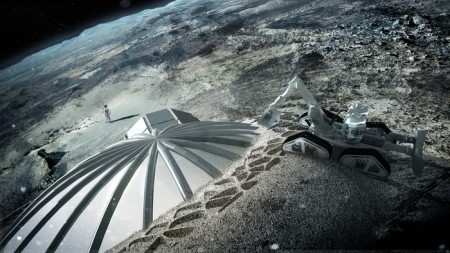May 27, 2016 – Russia wants to establish a permanent lunar base by the mid-2030s. A partnership between Roskosmos and the European Space Agency (ESA) includes mission plans to assemble a lunar settlement from inflatable and fixed structures that will first be launched into low-Earth orbit and then towed to the Moon during the 2020s where they will be assembled. The site locale is the Aitken Basin near the Moon’s South Pole where significant amounts of water have been detected. Roskosmos has proposed including a small, modular nuclear power source for the lunar settlement.
This is one of several Russian proposals for a permanent human presence on the Moon. Lin Industrial, a private Russian-based company, has published a draft plan to carry out 13 heavy-lift missions to build a lunar base using existing technology and new enhancements produced in the next half-decade. The Lin plan is also looking at a South Pole landing site, Malapert, a mountain plateau that receives continuous sunlight 89% of the time with night cycles of 3.6 days occurring only a few times a year. Lin’s plans are to provide much of the sites’ power using solar and battery technology.
The Russians are talking about “nationalizing” the lunar South Pole, a violation of International Space Law as agreed to by treaty.
Russia and ESA are not alone in their plans to establish a permanent human-occupied lunar base. China is equally interested with plans for human missions to the Moon in the 2020s and exploration of the Moon’s Dark Side following. Even the Japanese are getting into the act with speculative plans to build the first operating space elevator on the lunar surface.
What’s the attraction other than exploration and bragging rights? Two things.
- Helium-3. The unimpeded bombardment of the Moon’s surface by the solar wind has produced large deposits of this helium isotope. It literally can be scooped up from the lunar soil. On Earth Helium-3 can only be produced in the cores of nuclear reactors which makes it a pretty expensive and rare element. But its abundance on the Moon gives any lunar colony a high-value product for export back to Earth where the isotope can be used in fusion reactors providing a non-radioactive fuel and no dangerous waste products.
- Water. A company, Shackleton Energy, sees the existence of large quantities of water on the Moon as a business opportunity. The hydrogen and oxygen extracted from water would be stored as rocket fuel providing a filling station and jumping off spot for missions beyond the Moon. Shackleton sees the potential to export the hydrogen and oxygen and place it in low-Earth orbit to make it available to missions launched from Earth needing a fill up before heading into Deep Space.










